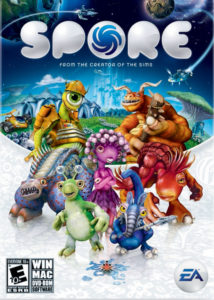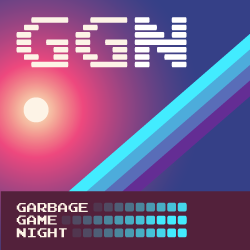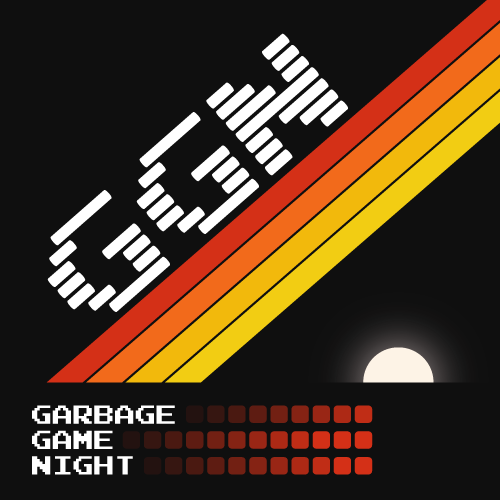
20 Jan Spore (PC)
 Spore, the 2008 Maxis game from famed developer Will Wright has a simple scope – ALL OF LIFE. With the largest scope of any game how could they possibly fail? The hype for this release was huge and the critic scores were pretty good, yet, in 2022 the idea that the game we got had been ‘ruined’ is everywhere. We played SPORE and have opinions! Chris, Frank, Tom, Carley and Hunter tackle life itself in this weeks episode!
Spore, the 2008 Maxis game from famed developer Will Wright has a simple scope – ALL OF LIFE. With the largest scope of any game how could they possibly fail? The hype for this release was huge and the critic scores were pretty good, yet, in 2022 the idea that the game we got had been ‘ruined’ is everywhere. We played SPORE and have opinions! Chris, Frank, Tom, Carley and Hunter tackle life itself in this weeks episode!
Chris’ Episode Notes:
Spore, a game that promised so much, that you would control a special from multi-cell organism into space-faring species and every step in between…how could it fall short? In this episode of Garbage Game Night we tackle the 2008 game from Maxis SPORE. After much hype, the developer of Simcity and hot off the heels of The Sims and The Sims 2 released SPORE.
Our previous experience of this game ranged from loving it and having high hopes to attempting to pirate it and never succeeding. Personally, I recall being very hyped for this game. I recall the prelaunch trailers, using the character creator before the full game came out and buying it on launch day. On this most recent playthrough I began to have doubts whether I had ever even finished it, but as I progressed along the stages and saw the galactic stage I recall clearly spending quite a bit of time in this world for… 2 weeks. After which I promptly never touched the game again until this episode. In a very Game-of-Thrones-fashion, it ceased being a part of my world instantly.
This Game in Context
It’s important to understand a game in the context it came out, so top games of 2008 included: GTAIV, Fallout 3, Little Big Planet, CoD: World at War, Super Smash Brothers Brawl, MGS4, Mario Kart Wii, Dead Space, Battlefield Bad Company, Gears of War 2, Mirrors Edge, Left 4 Dead, Devil May Cry 4, WoW: Wrath of the Lich King.
This game is in the ‘God Game’ genre, following on the coat tails of Populous, generally considered the first God Game from 1989 by Peter Molyneux. Black and White, from ’01 is a game we discussed quite a bit in the podcast and has had a lasting impact along with it’s sequel. Spore was launched 3 years after Black and White 2. From Dust was a 2011 arcade title in the God Game genre then follwed by Reus in ’13 and Godus in ’13.
In our podcast we discussed this stage by stage, because when you get down to it, this truly is 5 separate games built on the same engine. Sure, there things tying the games together but they are very, very, thin tendrils.
Cell Stage
In the first stage, ‘Cell Stage’, Life begins in the classic way, a meteor glances by a star and crashes into a planet, something something something, LIFE. You emerge as a single cell organism in a very snake… slither.io kind of environment where you’re trying to eat bits of food that give you DNA points and new body parts until you are able to evolve and you can modify your creature with things like pincers and flippers. You are in this primordial pool with other creatures – sometimes they are zippier than you, or bigger but you must craft your creature by adding spikes, mouths, jets to out-maneuver the competition and thrive.
As Tom said, he thought this stage of the game was where they got it best. The choices you make here matter, there is strategy to building your creature and, at least at first, the choices of your method for survival are exciting. Personally, I think this was fine for ’08, but for ’22, the handling and feel of it has not aged great. The creature builder holds up though. The experience of surviving in this pool is still fun, but does not have enough longevity to it. It reminded me of the PS3 arcade game flOw, which actually predated SPORE by some time and does some things better. I think 2 runs through this mode and you’ve seen it all.
Creature Stage
After collecting enough food, be it from other creatures or plants, you are forced into the next stage (technically, you could stick around, but you don’t get any more ‘points’ to work with, so your creature cannot grow any more). You are given the body part of ‘legs’ which you slap on your creature and can now venture off onto land. Your species is now living out of nests on land. Depending on how you are equipped you may find fruit to eat or just get violent and attack the other creatures and eat them. But between interacting with the other colonies and finding skeletons on the ground, you continue to unlock body parts in this new and expanded creature creator tool. The DNA progress bar on the bottom of your UI fills up again until you complete the stage.
This stage, I feel should really showcase your creature. You’re giving it multple arms, giving it poison spitters, wings, pincers, you can get creative here. And, I think if you approach this as a kid and create the monster of your wildest dreams, or nighhtmares, you can have some fun. But I’m dead inside, incapable of dreaming… What the game does is show you what claws are best, what mouth is best, by assigning them values. It’s hard not to min-max this experience and quickly put function over form. You can create awesome looking creatures, but the funcitonal stats on these monsters are fairly shallow, and in the end, it doesn’t matter if you have a mouth on your foot as long as you have a foot. It’s just a stat going into a column. Having 12 fanged mouths is no better than having 1 either. All that would be forgivable if the gameplay was enjoyable, but it’s not. You don’t earn your upgrades, you just find them on the ground. You don’t practice and get better at things, you just run up to other creatures and do a game of Simon Says to become friends or mash your attack keys a la WoW.
That takes us to the animations… perhaps the most disappointing part of the creature stage is that the algorithm doesn’t handle your creature’s features when you use an ability. For example, i’m getting a ‘bash’ ability from my big mace tail. When I click ‘bash’ my creature…. just lunges forward slightly. That it is on my tail, my face or my foot, my creature will just lunge forward slightly. Given, in 2008, it’s impressive that they sorted out how to make your creatures walk when you move their joints around, but it is very unfulfilling, as Tom pointed out, to put a row of poison spitters on your creature and being able to use ‘spit’ every 5 seconds as if you only had 1, and no animation matching it. At times, it felt like I was just staring at the hp bars tick down in fights without them doing any discernable fighting at all. After 5 minutes in, it began to feel like a slog.
Tribal Stage
The next stage, Tribal, was one we were all fairly baffled by. You evolve into a tribal state where you have a home base and a very crude form of RTS. there are a total of, perhaps 8 buildings you can create in predetermined slots around your leaders hut. You are no longer a single creature, but controlling groups. You click and drag to select multiple units and send them over to neighboring tribes to either play music with your digeridoos or swing violence at them with your axes until they are dead from it. You collect food from trees or their bodies to create more monster babies and this kind of continues until you are friends will all or you are on a pile of corpses.
I enjoyed this stage the least. It’s the same as the last but with a shift in the style to being more RTS, being top down. My main bone to pick was the pathing. Good god the pathing. You tell 3 of them to pick up some food and they just become completely dumbfounded. They’ve regressed to a single cell organism. It makes you appreciate pathing in games like Warcraft and Starcraft. You also can’t tell your units to ‘attack an area’. So you try to tell 3 guys to attack this monster and 2 to attack this one. Nope, they’re still going to stand in a line and maybe wander off in the other direction. They will inexplicably slow down then run into an ‘epic’ creature and die. There are 5 other tribes you have to deal with in this mode, none of them acknowledge each other as a threat, they are all vs you. Again, the gameplay is simply not enjoyable.
The creature creator in this stage allows you to append tribal style equipment to your creature. This is… mediocre.
Civilization Stage
Aptly named the civilization stage, you are looking to conquer the planet by dealing with the other civilizations. You have 3 ways to do this now; through religious means, economic or military. This stage also introduces ‘city planning’ along with the creator tool again to customize your own buildings and vehicles. The cities are in proximity of spice geysers, which you’ll have to control as the main means of buying more vehicles, creating trade routes and using your abilities to influence other civs, until the planet is yours.
I love the game civiliztation. Many times have I thought ‘just one more round’ and then hours have passed, the sun has risen and set, my family is begging me to come back. This stage is the most bastardized, simple version of civilization imaginable. And that it is within the SPORE universe does nothing for me. That it introduces the creator tool again is nice, but I found it a bit overwhelming to be forced to be creative so many times in a row. Of course, once you’ve created your own universe and your invested in this, i’m sure this is exciting and welcome, but I quickly was pulling other peoples designs from the sporepedia. The gameplay in this section works OK. It is fun to see your designs rolling, flying or sailing across the landscape but once the novelty is gone, again, it’s mediocre gameplay at best.
Galactic Stage
We have reached the 5th and final stage – Galactic. After conquering the globe you take to the stars. The potential for this game really opens up here. It’s ahrd to see where your limit of exploration ends, you’ve got what looks like thousands of star systems in view, each of those housing a handful of planets. You can zoom in on a planet to see the bases, continue to do the same base building you were in the previous stage and make them more efficient at producing space. Further, each planet has a terra-score about how inhabitable it is, and you can modify the planets by dropping devices in that will terraform it and help it house more colonies, thus producing more spice. Meanwhile, you’re using your funds to trade with other alien races, some of them aggressive, some super friendly, some religious, others distrusting. You can do missions for them, give gifts, make allies and upgrade your ship. It is kind of open-ended at this point but the final goal is to make it to the center of the galaxy.
To me, this is where it works best as a game. It’s odd that it, at this point has absolutely nothing to do with creature building. The scope of what you can do is pretty grand here. Running around doing missions that may include zipping down to an enemy planet and taking an artifact or eliminating some infected animals that threaten a planet and use your funds to improve spice manufacturing then finding the alien race that will pay the most for that variety of spice. Meanwhile your ally wants you to kill some aliens that you’re trying to be friends with. This most definitely has the most depth to it. In fact, if you were to go to the center of the galaxy without cheesing it, I’d wager your gameplay would be spent 85% or more in this mode. There’s simply a lot of game here.
More Spore
We can lose focus, now 14 years later, that this game was very much pushing the limits in many ways. I’m not going to tell you know exactly where procedurally generated tech was in 2008, but the game was using the ‘sporepedia’ (populated by other’s creations) to populate your world and generate the terrain and planets you explore throughout. I don’t recall feeling like there was a huge community in 2008 for this game, but oddly, while researching it I realized there were dedicated groups with featured winners, competitions, and to this day many people who love just creating monsters in the creator tool. Sure there are some 3d model builders out there, but this one works so well and was doing it well in 2008.
As Will Wright said, this was a Massively Parallel Single Player game, meaning that everyone’s single player experience was linking up with others in that creatures from other peoples games would ‘pollinate’ your copy, bringing in their monsters and enriching your experience. It was creative that so much of the content was reliant on the community be it creatures, buildings or ships.
Notable Devs
Of course Will Wright was the main project lead on Spore but he had a capable team that came from great games and continued to make great games. Will wright himself spoke about how he saw games as a complex learning tool and not something that shunted creativity
- Australian designer Alex Hutchinson had worked on the Sims then went on to Assassins Creed 3, Far Cry 4 and now works for Racoon Logic
- Chaim Gongold seemed responsible for the design of the creature creator and the Sporepedia.
- Stone Librande had been lead designer on D3 and is now a designer at Riot Games
- and Soren Johnson actually came from a background in Civilization, he’d later go on to help create Offworld Trading Company
Beyond Spore
The game quickly got support with an expansion pack called Creepy and Cute as well as several spinoffs including the DS game Spore Creatures, Spore Hero for the wii and a mobile game called Spore Origins which focuses on the cell stage. Galactic Adventures was the only full fledged expansion for Spore which added in missions into the galactic stage which you could beam down onto the planet to complete. These again were largely powered by community creations. I’d be remissed to leave out Dark Spore. After Will Wright left, Maxis decided to create a Diablo style game using the Spore engine… it’s servers were shut down 3 years after launch making the game completely inaccessible.
Spore Score
The Metacritic Score for Spore stands at 84, so fairly favorable. The user score however is a 5.7. There was quite a bit of negativity surrounding the launch of this game, some around the difference in some of the promotional materials to the final game, but mostly around the DRM. This game did ship with SecureROM, a Digital Rights Management software to ensure your version was legitimate. It was so restrictive that you could not use your CD key to install the game more than 3 times (this was later increased). A class action suit was filed against EA for failing to mention SecureROM anywhere in the EULA and it continued to be a dark cloud over this game.
Our own scores during the podcast all stayed positive. While we enjoyed the creature creator we all wished it had more depth and wished a spore 2 was on the way.
References:
Wikipedia
Moby Games
Steam Link
Gameplay Link
Main Trailer
Teaser Trailer
What Spore Could Have Been 1
What Spore Could Have Been 2




No Comments